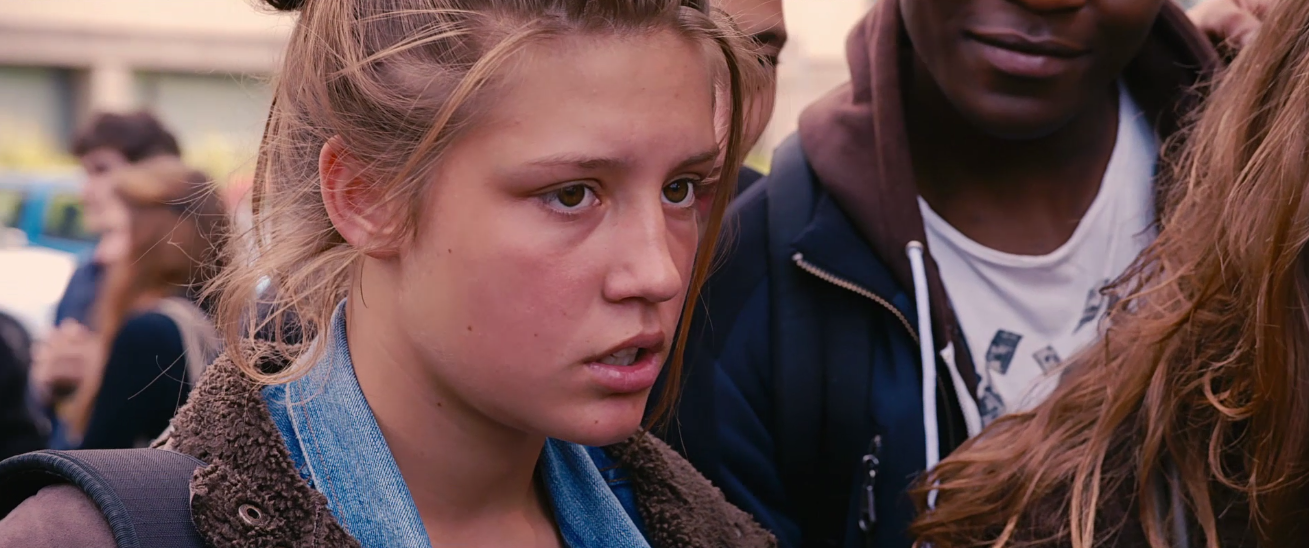Title: Blue is the Warmest Color (La vie d’Adèle, Chapitres 1 et 2)
Sundance Selects
Director: Abdellatif Kechiche
Screenwriter: Abdellatif Kechiche, Ghalya Lacroix, loosely adapted from the graphic novel “Blue Angel,” or “Le bleu est une couleur chaude” by Julie Maroh
Cast: Léa Seydoux, Adèle Exarchopoulos, Salim Kechiouche, Jérémie Laheurte, Catherine Salée, Aurélien Recoing, Mona Walravens, Fanny Maurin, Benjámin Siksou, Sandor Funtek
Screened at: Review 1, NYC, 10/17/13
Opens: October 25, 2013
Let me take a stab at what you’re going to say as you leave this film. “In my next life, I want to be French.” As we can see by Abdellatif Kechiche’s latest film, the French enjoy the following more than those of other persuasions: love, sex, language, food, wine, art, and literature. The only category that the director does not get to mention is that the French have the best health care delivery system in the world. Is it any wonder that joie de vivre is a French term?
Kechiche, perhaps best known for “Games of Love and Chance,” about a tough who acquires a taste for the classics when he meets a girl who wants to be an actress, is himself playing games of love and chance with “Blue is the Warmest Color.” We wouldn’t have it any other way. The picture has the French title “La vie d’Adèle: Chapitres 1 et 2.” The gamesmen are Adèle (Adèle Exarchopoulos), a fifteen-year-old high-school girl, and Emma (Léa Seydoux), a college senior presumably four years older than Adèle. “Blue” is not only a coming-of-age story and a comic-out story (with the emphasis on “coming”) but a tale involving a conflict of social class. The older woman, who sports painted blue hair, has a passion for art and philosophy. She at first appears to be slumming with her working class love interest but who, throughout the selective scenes involving ten years in their lives, displays a bond a genuine affection and equality. Never mind that Adèle never feels comfortable when participating in Emma’s circle of friends.
Exarchopoulos, who is in virtually every frame, is arguably among the most adorable young actresses that her country has produced. It helps quite a bit that when she is alone with her significant other, her chemistry with Seydoux is palpable. The movie would have nowhere to go without that obvious display of passion and tenderness. Though the naked body is seen in far more explicit scenes than it would be if simply posing for paintings, the heart is the most prominent organ actually on display—which among other factors raises the film far above the prurient.
Using medium focus to connect the picture to the wide screen, director of photography Sofian El Fani hones in on Adèle, who at the age of fifteen is a composite of teen emotions. She exhibits highs and lows, the former often making up for the latter, emotions that tend to become more stable as a person matures. During the ten years in which “Blue” takes place, Adèle is often confused, overwhelmed by the artsy people she meets, but her emotions are anchored in the arms of her great love. If her first sexual contact with Thomas (Jérémie Laheurte) is disappointing (she may be faking an orgasm), causing Adèle to wonder whether something is wrong with her, she happily discovers what sex is all about when she is introduced to its glories by Emma. Members of the audience will likely be split in considering whether the long moments of sexual union between the two are necessary to advance the plot, but in so-called legit cinema, I’ve never before seen lesbian sex in such graphic detail.
Tunisian-born director Kechiche wants to show us some of the wonderful pleasures that life has to offer, such as good conversation (Sartre becomes a topic for the two women to examine), literature (students read and discuss Marivaux’s “La vie de Marianne”), painting and sketching (Adèle poses for her lover and is exhibited in a gallery), but especially the more physical joys of eating and sex. Class differences are shown in the choices of menus. When Emma invites Adèle to meet her parents, we find the older couple relaxed and presumably aware of their daughter’s lesbianism. They dine on oysters, the dad noting that the fish must be served alive to be fresh. When Adèle has Emma over to her parents, they are served pasta—which prompts Emma’s backhand compliment that the dish is “simple but delicious.”
With sex depicted from every camera angle with no body doubles used or needed, with food conspicuously and sensually entering mouths (shades of the famous scene from Tony Richardson’s 1963 film “Tom Jones”), and with authentic performances from the starring couple, “Blue,” at 187 minutes with end-credits is overlong and predictable, but equipped with a pair of stunning performances and is a primer on lesbian love.
Rated NC-17. 179 minutes © 2013 by Harvey Karten, Member, New York Film Critics Online
Story – B
Acting – B+
Technical – B+
Overall – B+

